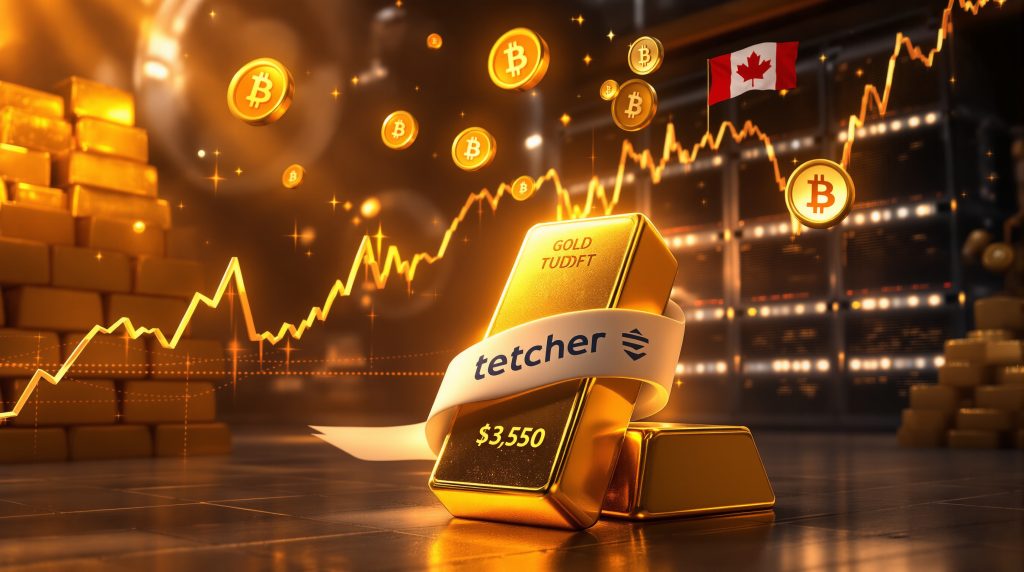How Is Tether Building Its Gold Portfolio?
Tether Holdings SA is significantly expanding its gold investment strategy through a multi-pronged approach that extends beyond traditional cryptocurrency backing. The stablecoin issuer recently announced plans to invest approximately $100 million to increase its stake in Elemental Altus Royalties Corp., a Canadian company specializing in mining revenue streams. This follows Tether's earlier acquisition of a 37.8% ownership position in the firm, demonstrating a pattern of strategic investment in the precious metals sector.
Current Gold Holdings and Investment Strategy
Tether currently maintains physical gold reserves valued at approximately $8.7 billion (as of June 2025), with gold bars stored in secure Swiss vaulting facilities. This substantial holding forms a cornerstone of the company's diversification strategy beyond purely digital assets.
The company's investment in Elemental Altus represents a strategic move to gain exposure to mining royalties, providing Tether with revenue streams from multiple mining operations without assuming direct operational risks.
Juan Sartori, Executive Chairman of Elemental Altus, confirmed that "Tether's recent investment was based on its strategy of increasing gold exposure," highlighting the deliberate nature of this expansion.
The company's expanded gold strategy represents a significant diversification of its asset portfolio beyond purely digital holdings, positioning Tether at the intersection of cryptocurrency and traditional commodity markets.
Why Is Tether Investing Heavily in Gold?
Market Conditions Driving Gold Investment
The timing of Tether's expanded gold strategy coincides with extraordinary market conditions in the precious metals sector. Gold prices analysis 2025 shows unprecedented levels, with spot prices recently surging above $3,550 per ounce and approaching the $3,600 threshold. This remarkable price momentum has created a favorable environment for strategic gold acquisitions.
The precious metal's rally has been primarily driven by anticipation of U.S. Federal Reserve interest rate cuts under President Trump's administration, which many market analysts believe could potentially fuel inflation. This economic backdrop has created strong demand for gold as a traditional inflation hedge.
Strategic Rationale Behind Tether's Gold Focus
Tether's gold acquisition strategy serves multiple business objectives that strengthen its position in both traditional and cryptocurrency markets:
-
Reserve Diversification: By reducing reliance on traditional financial instruments for backing USDT, Tether creates a more robust reserve structure that can withstand various market conditions.
-
Asset Protection: Physical gold provides tangible commodity backing with intrinsic value, offering protection against digital asset volatility.
-
Market Correlation: Tether is leveraging the perceived relationship between gold and Bitcoin as stores of value, with many investors viewing Bitcoin as "digital gold."
-
Inflation Hedge: Gold's historical performance during inflationary periods provides Tether with protection against potential currency devaluation.
-
Credibility Enhancement: Substantial gold holdings strengthen investor confidence in Tether's asset backing, addressing past concerns about reserve adequacy.
This multi-faceted approach reflects a sophisticated understanding of both traditional and digital asset markets, positioning Tether uniquely within the financial ecosystem.
What Is USDT and How Does Gold Support It?
Understanding Tether's Stablecoin Foundation
USDT (Tether) is the world's largest stablecoin by market capitalization, designed to maintain a consistent 1:1 peg with the U.S. dollar. Unlike more volatile cryptocurrencies, USDT aims to provide stability through reserve backing. The stablecoin serves as a crucial bridge between traditional finance and cryptocurrency markets by offering:
A stable trading pair for cryptocurrency exchanges, enabling traders to move in and out of volatile positions without converting to fiat currency.
A medium for cross-border value transfer that maintains dollar-equivalent value without traditional banking delays.
A dollar-equivalent digital asset for traders and investors who want cryptocurrency exposure without volatility.
A liquidity source for decentralized finance (DeFi) applications, facilitating lending, borrowing, and yield generation.
Gold's Role in Tether's Reserve Structure
Gold has become an increasingly significant component of Tether's reserve strategy, with its $8.7 billion in physical gold holdings providing substantial backing for its stablecoin operations. As a unique gold trading asset, this precious metal allocation serves multiple strategic purposes within Tether's reserve framework:
| Reserve Component | Strategic Purpose | Benefit to USDT |
|---|---|---|
| Physical Gold Bullion | Tangible asset backing | Inflation protection |
| Gold Royalty Investments | Exposure to production upside | Diversified revenue streams |
| Gold-Backed Token (XAUT) | Direct gold tokenization | Alternative product offering |
| Mining Industry Stakes | Supply chain integration | Strategic market positioning |
This diversified approach to gold investment provides multiple layers of support for Tether's stablecoin ecosystem while potentially generating additional revenue streams through mining royalties and price appreciation.
How Does Tether's XAUT Gold Token Work?
Gold Tokenization Mechanics
Beyond its USDT stablecoin, Tether offers XAUT, a specialized token fully backed by physical gold. Each XAUT token represents ownership of physical gold stored in Swiss vaults, with Tether having issued approximately $1.3 billion worth of these tokens to date.
The token provides several distinct advantages for investors seeking gold exposure through cryptocurrency markets:
Direct gold price exposure without physical storage concerns or high custodial fees.
Blockchain-based ownership verification that enhances transparency and security.
Fractional gold ownership capabilities, allowing for smaller investment amounts than typically possible with physical gold.
Redemption rights for physical gold, with collection available in Switzerland for investors who want to convert their digital tokens to tangible assets.
Seamless integration with cryptocurrency exchanges and wallets, enabling efficient trading and portfolio management.
XAUT Market Position and Growth
Tether's $1.3 billion in XAUT issuance represents a significant portion of the gold-backed token market, demonstrating substantial investor interest in blockchain-based precious metal ownership. The growth of XAUT complements Tether's broader gold strategy by:
-
Providing a direct gold investment vehicle for crypto users who want commodity exposure within digital asset ecosystems.
-
Creating synergies with physical gold holdings, allowing Tether to leverage its existing precious metals infrastructure.
-
Expanding Tether's product ecosystem beyond dollar-pegged assets to capture different market segments.
-
Capturing market share in the growing tokenized commodity sector, positioning Tether as an innovator in digital asset-commodity bridges.
The XAUT token effectively bridges traditional precious metals markets with blockchain technology, creating a new investment category that combines gold's historical stability with cryptocurrency's accessibility and transferability.
What Does Tether's Investment in Elemental Altus Signify?
Strategic Value of Mining Royalty Companies
Tether's decision to increase its stake in Elemental Altus Royalties Corp. represents a sophisticated approach to gold market exposure. The mineral deposit guide explains how mining royalty companies offer several advantages compared to direct mining operations:
Reduced Operational Risk: Royalty companies avoid direct mining costs, labor challenges, environmental liabilities, and operational disruptions by simply collecting a percentage of revenue from operating mines.
Portfolio Diversification: Exposure to multiple mining projects across different geographies provides natural risk distribution and reduces dependency on any single operation.
Revenue Predictability: Contractually guaranteed income streams from producing mines offer more stable cash flows than direct mining operations.
Inflation Protection: Royalties typically increase in value during inflationary periods as commodity prices rise, providing natural protection.
Growth Potential: Royalty companies benefit from resource expansion and new discoveries at existing mines without funding additional development costs.
Tether's Expanding Stake in Elemental Altus
The additional $100 million investment will significantly increase Tether's influence in Elemental Altus, potentially providing greater control over strategic decisions. The transaction is expected to close in Q4 2025, subject to shareholder approval.
This deepening relationship with Elemental Altus may provide Tether with:
-
Enhanced visibility into gold mining operations across multiple jurisdictions and projects.
-
Potential board representation and governance input, allowing Tether to influence strategic direction.
-
Priority access to future royalty opportunities through established industry relationships.
-
Strategic positioning within the precious metals sector beyond simply holding physical gold.
-
Diversified exposure to multiple mining projects at various development stages.
By taking a significant position in a mining royalty company rather than simply accumulating physical gold, Tether demonstrates a sophisticated understanding of the gold market ecosystem and positions itself to benefit from multiple aspects of the gold value chain.
How Does Gold Compare to Bitcoin as a Store of Value?
Comparing Traditional and Digital "Gold"
Tether's dual investment in both physical gold and cryptocurrency infrastructure highlights the evolving relationship between traditional and digital stores of value. Both assets offer distinct characteristics that appeal to different investor preferences:
| Characteristic | Physical Gold | Bitcoin |
|---|---|---|
| Historical Track Record | Millennia of proven value | 16 years since creation |
| Supply Dynamics | Limited but still mined | Fixed maximum supply (21 million) |
| Storage Requirements | Physical security needed | Digital security required |
| Divisibility | Limited practical divisibility | Highly divisible (to 8 decimal places) |
| Transaction Efficiency | Physical transfer limitations | Near-instant global transfers |
| Regulatory Status | Well-established legal framework | Evolving regulatory landscape |
| Market Volatility | Relatively stable with gradual appreciation | Significant price volatility |
Strategic Complementarity
Rather than viewing gold and Bitcoin as competitors, Tether appears to be positioning them as complementary assets within a diversified portfolio approach. Many market participants have described Bitcoin as "digital gold" due to its scarcity and potential store-of-value characteristics.
By investing heavily in gold while maintaining its position in cryptocurrency markets, Tether is creating a hybrid approach that captures potential benefits from both worlds. The gold–silver ratio insights further demonstrate how traditional precious metals can complement modern investment strategies. This approach acknowledges that different market conditions may favor different types of assets at various times, allowing Tether to maintain stability through diversification.
The company's approach suggests a forward-looking perspective that recognizes both the historical role of gold in preserving wealth and the emerging potential of digital assets to transform value storage and transfer in the digital age.
What Are the Risks and Challenges of Tether's Gold Strategy?
Operational Complexities
Tether's expanded gold strategy introduces several operational challenges that must be carefully managed:
-
Physical Security: Safeguarding billions in gold bullion requires sophisticated security measures, including specialized vaulting facilities, insurance coverage, and security protocols.
-
Custody Verification: Ensuring transparent verification of physical gold holdings presents challenges around auditing, certification, and chain of custody documentation.
-
Regulatory Compliance: Navigating varying international regulations on precious metals involves compliance with import/export laws, anti-money laundering requirements, and sanctions considerations.
-
Industry Expertise: Developing mining sector knowledge for effective investment decisions requires specialized talent and industry connections.
-
Market Timing: Managing acquisition timing in a volatile gold price environment creates challenges around valuation and opportunity cost.
Financial and Market Considerations
The financial implications of Tether's gold strategy include:
Opportunity Cost: Capital allocated to gold cannot be deployed in potentially higher-yielding investments, creating trade-offs around capital efficiency.
Market Correlation Risk: Despite diversification benefits, there remains potential for synchronized downturns in both crypto and precious metals markets during severe economic stress.
Liquidity Management: Balancing liquid reserves with less liquid physical assets requires sophisticated treasury management to ensure redemption capabilities.
Valuation Volatility: Managing balance sheet fluctuations due to gold price movements introduces accounting and reserve calculation complexities.
Stakeholder Expectations: Maintaining transparency about reserve composition remains crucial for maintaining trust in the Tether ecosystem.
These challenges highlight the complexity of Tether's diversification strategy and the need for sophisticated risk management frameworks to successfully implement this approach.
How Might Tether's Gold Strategy Impact the Broader Market?
Potential Industry Effects
Tether's significant gold acquisitions and investments could influence several market dynamics across both traditional finance and cryptocurrency sectors:
-
Increased Institutional Interest: Tether's strategy could accelerate traditional finance involvement in both gold and crypto by demonstrating viable bridges between these previously separate markets.
-
Supply Chain Integration: The company's investments create new connections between mining operations and digital finance, potentially leading to more blockchain integration in commodity markets.
-
Market Validation: Tether's substantial gold holdings lend credibility to gold-backed digital assets as a viable financial product category.
-
Competitive Responses: Other stablecoin issuers may implement similar strategies to differentiate their offerings and strengthen their reserve structures.
-
Price Support: Tether's ongoing gold acquisitions could contribute to sustained demand for physical gold, potentially supporting price levels.
Future Expansion Possibilities
Based on current trends, Tether may further develop its gold strategy through several potential pathways:
Additional mining royalty acquisitions to expand revenue streams and market influence.
Direct investment in mining operations to secure supply chain positioning.
Expanded gold-backed token offerings targeting different market segments.
Integration with gold derivatives markets to enhance hedging capabilities.
Development of gold-focused financial products that bridge traditional and digital finance.
These potential developments could position Tether as a significant player in reshaping how gold and digital assets interact within the broader financial ecosystem.
What Other Entities Are Pursuing Gold Acquisition Strategies?
National and Institutional Gold Strategies
Tether's gold focus parallels similar moves by various nations and institutions, indicating a broader trend toward precious metals as strategic assets:
El Salvador: Recently purchased $50 million in gold for reserve diversification, representing the nation's first gold acquisition since 1990. This move follows the country's earlier Bitcoin adoption, suggesting a diversified approach to alternative reserves.
Central Banks Globally: Many monetary authorities have continued as net buyers of gold, adding to strategic reserves as a hedge against currency volatility and geopolitical uncertainty.
Institutional Investors: Many pension funds, family offices, and asset managers have increased allocations to precious metals amid economic uncertainty and inflation concerns.
Sovereign Wealth Funds: Several national investment vehicles have built gold positions as portfolio stabilizers and diversification tools.
Mining Companies: The sector has seen accelerated consolidation activity as firms seek to secure gold reserves and production capacity in a favorable price environment.
Comparative Approaches
Different entities approach gold acquisition with varying strategies tailored to their specific objectives:
| Entity Type | Primary Acquisition Method | Strategic Objective |
|---|---|---|
| Central Banks | Direct bullion purchases | National reserve security |
| Investment Funds | ETFs and mining stocks | Portfolio diversification |
| Technology Companies | Treasury diversification | Inflation protection |
| Cryptocurrency Firms | Physical and tokenized gold | Stablecoin backing |
| Private Investors | Coins and small bars | Personal wealth protection |
This diverse approach to gold acquisition across different market participants highlights the metal's versatility as a strategic asset in various contexts, from national reserves to corporate treasuries to investment portfolios.
What's Next for Tether's Gold Strategy?
Near-Term Developments to Watch
Several upcoming milestones may provide further insights into Tether's evolving gold strategy:
-
Elemental Altus Deal Closure: Expected in Q4 2025, subject to shareholder approval, this transaction will significantly increase Tether's influence in the mining royalty sector.
-
Reserve Composition Reports: Quarterly updates on Tether's gold holdings will reveal whether the company continues to expand its physical gold position.
-
XAUT Expansion: Growth metrics for Tether's gold-backed token issuance will indicate market demand for this product category.
-
Additional Acquisitions: Potential further investments in mining and royalty companies would signal a deepening commitment to the gold ecosystem.
-
Product Innovation: New gold-related financial offerings could emerge from Tether's expanding precious metals expertise.
Long-Term Strategic Implications
Tether's expanded gold strategy signals a potential long-term shift in how digital asset companies approach reserve management and asset backing. This evolution may lead to:
-
Greater integration between traditional commodities and digital finance, creating new hybrid financial products and markets.
-
Increased transparency requirements for stablecoin reserves, setting new industry standards for asset backing.
-
New financial products combining physical and digital assets to serve emerging market needs.
-
Enhanced legitimacy for cryptocurrency companies in traditional finance through tangible asset backing.
-
Broader institutional acceptance of diversified reserve strategies that include both digital and physical assets.
These developments could reshape market perceptions about the relationship between traditional commodities and digital assets, potentially creating new investment categories that bridge these previously separate worlds.
How Can Investors Interpret Tether's Gold Strategy?
Key Takeaways for Market Participants
Tether's gold expansion offers several insights for different stakeholders in both traditional and digital finance:
For Cryptocurrency Investors:
Tether's strategy signals growing maturity in stablecoin reserve management, moving beyond purely financial instruments.
The company's commitment to tangible asset backing may enhance confidence in the stability of its stablecoin ecosystem.
The approach suggests continued belief in the complementary nature of digital assets and traditional stores of value.
For Traditional Gold Investors:
Tether's acquisitions indicate new sources of institutional demand for physical gold beyond traditional market participants.
The strategy highlights emerging connections between precious metals and digital finance that could reshape market dynamics.
The company's investments suggest potential for increased price support from non-traditional buyers with significant capital resources.
For Financial Markets:
Tether's approach represents evolving hybrid strategies to asset management that blur traditional investment categories.
The strategy demonstrates increasingly porous boundaries between traditional and digital finance.
The company's moves signal potential for new financial products that bridge commodity markets and blockchain technology.
Furthermore, investors interested in this sector should also consider various gold mining stocks types as another way to gain exposure to the gold market alongside Tether's innovative approach.
Frequently Asked Questions About Tether's Gold Strategy
Common Questions About Tether's Gold Investments
Q: How much gold does Tether currently hold?
A: Tether holds approximately $8.7 billion in physical gold as of June 2025, stored in secure Swiss vaults, according to company disclosures.
Q: Can USDT holders redeem their tokens for gold?
A: USDT is backed by a diversified reserve that includes gold among other assets, but standard USDT tokens are not directly redeemable for gold. However, Tether's XAUT tokens are specifically designed for gold redemption.
Q: How does Tether verify its gold holdings?
A: While specific verification processes are not fully disclosed, Tether works with third-party auditors and custodians to verify its physical gold reserves as part of its broader reserve attestation process.
Q: Will Tether's gold purchases affect global gold prices?
A: While Tether's gold acquisitions are substantial for a private company, they represent a relatively small portion of the global gold market. However, continued large-scale purchases could contribute to price support, especially if other institutional buyers follow similar strategies.
Q: How does Tether's gold strategy compare to central bank gold reserves?
A: Tether's gold holdings are significant for a private company but remain smaller than major national reserves. However, according to recent reporting by FXStreet, Tether's acquisition rate has been notably aggressive compared to most central banks, reflecting its focused diversification strategy.
The company's expanded gold strategy represents a significant innovation in how digital asset companies approach reserve management, potentially influencing both cryptocurrency markets and traditional finance as these sectors continue to converge.
Ready to Spot the Next Major Mineral Discovery?
Discovery Alert's proprietary Discovery IQ model instantly notifies you of significant ASX mineral discoveries, turning complex data into actionable investment opportunities that could generate substantial returns. Visit the Discovery Alert discoveries page to explore historic examples and begin your 30-day free trial to position yourself ahead of the market.




